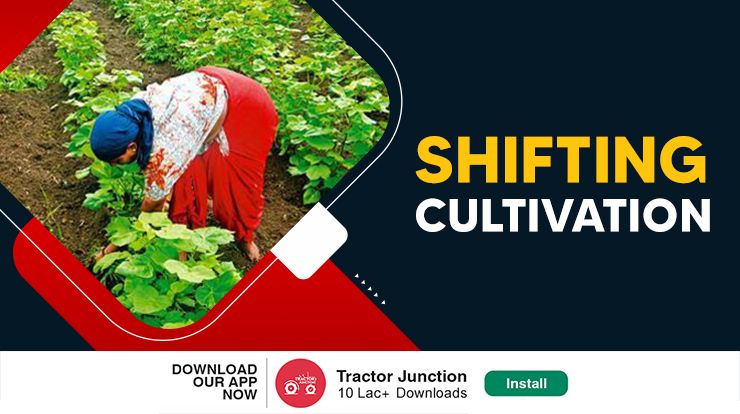
What is Shifting Cultivation
Shifting Cultivation is a form of farming, where farmers cultivate the land temporarily for two or three seasons. Then they abandon the land and leave it to allow vegetables to grow freely. After that, farmers move to a different place. They leave the place when the soil gets out of fertility or land is overrun by weeds. The cultivation time is generally less than when the ground is allowed to regenerate fertility.
There is still the use of shifting farming in India. That is being used in the hilly areas of the North-Eastern Region, Andhra Pradesh, Sikkim, Bihar, Orissa, Madhya Pradesh, Tamil Nadu, Maharashtra, Kerala and Karnataka.
How is Shifting Cultivation Practiced?
It is a way of farming long followed in the humid tropics of southeast Asia, Sub-Saharan Africa, and South America. In Shifting agriculture in India, farmers would cut and burn the native vegetation. Then they sow crops in the ash-fertilized and exposed soil for 2 or 3 seasons in succession.
Characteristics of Shifting Cultivation
- It is ecologically viable if enough land for long (about 10 to 20 years) is restorative.
- The demand and need for food should not be too high.
- This system is suited for harsh environmental conditions and fragile ecosystems of the tropics.
- And that is the reason we have only limited success in finding viable alternatives to Shifting agriculture in India.

Types of Shifting Cultivation
The different types of shifting agriculture are the slash-and-burn, shifting cultivation cycle in the Orinoco floodplain, Chitemene system, Hmong system, the slash-mulch system and the plough-in-slash system.
Importance of Shifting Cultivation
The Importance of it includes the advantages and disadvantages of this farming. So, let’s know about the pros & cons one by one.
Shifting Cultivation Advantages and Disadvantages
There are several advantages of Shifting farming. But, also, it has a few disadvantages. So, we have noted some advantages and disadvantages of Shifting farming in the below section.
1. Advantages of Shifting Cultivation
- The crops’ growth will start fast in this Cultivation, and sometimes it will get ready for harvest early.
- And there is no danger or fear for the crop-destroying animals and flood in It.
- In this farming, the soil bone diseases are also reduced significantly.
- After slash and burn, it is easy to grow crops.
2. Shifting Cultivation Disadvantages
- There is a loss of 22% of the top of the soil, which is full of fertility in Shifting agriculture. Therefore, it causes the loss of economic rate of people.
- As it has raw sewage and oil residue, water pollution can easily occur in it.
- The Shifting cultivation process also restricts the land-use intensity.
- Loss of biodiversity is also an impact of shifting agriculture, and it is uneconomical.
Shifting Cultivation Process
(a). Each year farmers choose an area for planting.
(b). They have to remove vegetation that typically covers the land.
(c). They cut most of the trees with the help of axes, which are economically helpful.
(d). After that, they burn the debris carefully.
(e). Rains mix the ashes into the soil, which provide needed nutrients.
(f). In different regions, the cleared area is called Swidden, Ladang, milpa, Chena, and Kaingin.
(g). They cultivate the cleared land only briefly, usually three or fewer seasons.
(h). Farmers leave the old site uncropped for 10 to 25 years.
(i). They will return to the land after 10 to 20 years to cultivate again.
(j). They can care for fruit-bearing trees on the ground during the site leaving.
Example of Shifting Cultivation
Shifting farming is an example of subsistence, extensive and arable farming. In the rainforest, it is one of the traditional forms of agriculture. The Amazonian Indians mostly do this farming in South America. They use the land for 2 to 3 years before moving to another area.
FAQs of Shifting Cultivation
Que. Different Names Of Shifting Cultivation in India
Ans. Dhya, Penda, Bewar, Nevad, Jhum and Podu are the different names of Shifting Agriculture.
Que. Where is Shifting Cultivation Practiced In India?
Ans. Shifting Agriculture is practiced in hilly areas in India, including Andhra Pradesh, Sikkim, Bihar, Orissa, Madhya Pradesh, Tamil Nadu, Maharashtra, Kerala and Karnataka.
Que. What is an Example of Shifting Cultivation?
Ans. Subsistence farming, extensive farming and arable farming are examples of Shifting agriculture.
Que. What is The Other Name of Shifting Cultivation?
Ans. It is other Name as Jhum Cultivation or Slash and Burn Agriculture.
Que. What are The Main Features of Shifting Cultivation?
Ans. Rotation of fields, Use of fire for clearing the land, Keeping the land fallow for regeneration Use of human labor, Non-employment of draught animals, Non-use of the plough, Grows mixed crops
Related Blog
Protected Cultivation in India
Mixed Farming in India


